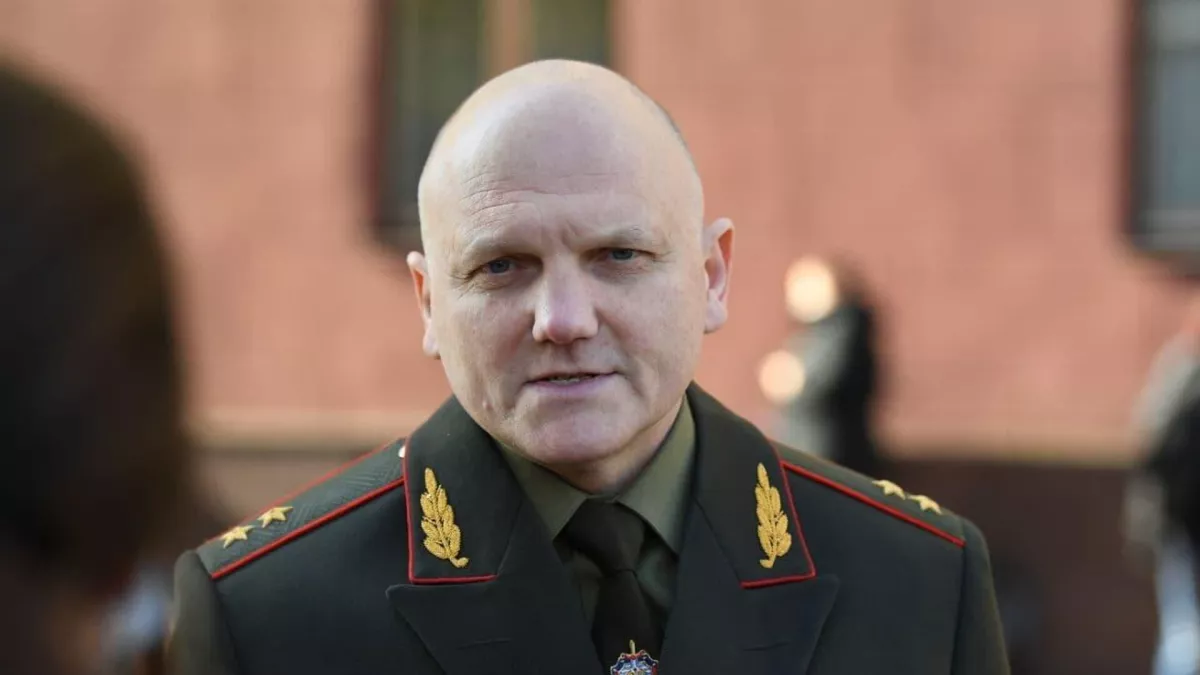The “Liberation Army” vs. official Minsk Exiles plot regime change
According to the Belarusian State Security Committee (KGB), emigrants in Poland and Lithuania are being organised into full-fledged military units built to NATO standards. Is a new scenario of civil war being prepared for Belarus?
Armed radicals as “messengers of democracy”

Speaking on October 23 at the Third CIS Conference on Countering Terrorism and Extremism in Dushanbe, First Deputy Chairman of the KGB Sergei Terebov reported plans for a violent change of power in Belarus being hatched in the West. Among those plans is the creation, in EU countries, of a “Belarusian Liberation Army” made up of three brigades.
The envisaged strength of such formations could be between 9,000 and 15,000 personnel. The main objective of this illegal armed formation (IAF) is to invade Belarusian territory to oust the current authorities and install a pro-Western nationalist regime; this may be preceded by terrorist activity.
The backbone of the “liberation army” would be militarised groups already operating in Poland, Lithuania and Ukraine. Recruitment of new members is also taking place in the Czech Republic. In Poland, some units are reportedly being trained under the supervision of serving Polish military personnel.
“‘The main elements of training for such fighters are the use of UAVs, including strike drones; tactics for solo and group actions in urban environments; storming buildings; preparation for carrying out sabotage and terrorist acts; the basics of mine-and-explosive work; and the manufacture of improvised explosive devices,’” Sergei Terebov said.
Live-fire drills with weapons and drones are being conducted on mock-ups of government administration buildings and military facilities of the Republic of Belarus. All potential candidates undergo thorough screening by local special services, including polygraph testing. Around a thousand Belarusian radicals have already gained combat experience during the conflict in Ukraine, but most of them are currently in Poland and Lithuania.
Titans and terror

After the mass unrest during the 2020 presidential election, large numbers of participants ended up emigrating to EU countries. The largest Belarusian community lives in Poland: according to the Polish social insurance system (ZUS), about 135,000 citizens of the Republic of Belarus are registered. Taking into account those who do not pay contributions to ZUS, their number may exceed 200,000. It is also estimated that around 50,000 Belarusian citizens are in Lithuania, and more than 30,000 in Germany and other EU countries. Thus, a potential recruitment pool theoretically exists. But how many migrants can be persuaded to join illegal armed formations and take up arms?
Practice shows the following. Belarusian radicals have participated in armed conflict on Ukrainian territory since 2014, when the tactical group “Belarus” and the “Pohonia” detachment were formed within the Armed Forces of Ukraine. However, the number of volunteers in these units during the Anti-Terrorist Operation (ATO) did not exceed a few dozen people.
With the start of full-scale hostilities in 2022, new and larger units of Belarusian emigrants emerged: the “Litvin,” “Volot,” “Titan,” “Terror,” and “Kastus Kalinouski Regiment” (KKR) battalions. After internal clashes, “Litvin” and “Volot” joined the KKR, while “Terror” broke away.
At the end of 2022, representatives of the “Terror” and “Titan” battalions, together with the Belarusian unit of the Ukrainian organisation “Tradition and Order,” announced the creation of the “Belarusian Volunteer Corps” (BVC). All of these formations are recognised as extremist organisations in Belarus.
The core of these Belarusian units was made up of far-right football fans, activists of nationalist organisations such as the “Young Front,” and other active participants in the 2020 events. One of the coordinators of such formations is reportedly the well-known right-wing radical Sergey Korotkikh (“Botsman”), a former Belarusian citizen linked to Belarusian, Russian, and Ukrainian nationalist groups. He was suspected in Russia of murdering two Dagestanis in 2007, with footage of the crime showing Nazi symbols.

In 2024, former KKR member Vasiliy Veremeychik (call sign “Patsuk”) was extradited to Belarus from Vietnam. According to Veremeychik, the “Kastus Kalinouski Regiment” never had “more than 300 people.” Overall, around 1,000 Belarusian citizens have passed through various units during combat operations.
The KKR itself typically does not hold a separate section of the front; its fighters periodically undertook local missions, likely mainly to gain combat experience. Judging by posts on its Telegram channel, the activity of the “Kastus Kalinouski Regiment” has been low recently: in 2025, posts appeared with long intervals, the latest in August.
At the same time, the KKR publicly supported Belarusian opposition leader Sviatlana Tsikhanouskaya, despite significant tensions between her office and the KKR. The European Parliament adopted a resolution supporting this illegal armed formation (IAF). In Belarus, the KKR is recognised as a terrorist organisation, and criminal cases have been opened against several of its members.
Representatives of the KKR have repeatedly stated their goal of overthrowing the current president and creating a “free and democratic republic.” They have also claimed the existence of “significant reserves in Belarus” and, together with Sviatlana Tsikhanouskaya, urged Belarusians to “wait for the signal” to “begin the operation to liberate Belarus.”
Banners from abroad
Since 2022, the Belarusian radical opposition in Poland and Lithuania has begun forming the so-called “Pospolite Ruch” — modelled on the mounted nobility militias of the Polish-Lithuanian Commonwealth. Modern nationalists named their units “banners” (khoruhvy).
In 2022, there were the “Gdańsk Banner,” “Wrocław Banner,” “Vilnius Banner,” “Warsaw Banner,” and “Białystok Banner.”

By 2023, their number had increased to seven. According to Ivan Tertel, Chairman of the Belarusian KGB, the most aggressive was the “Białystok Banner,” led by former cadet of the Belarusian Military Academy Asadulayev (call sign “Shlyakhtich”).

These formations were coordinated by former Belarusian security officers who went over to the opposition — in particular Valery Sakhaschik, the ex‑commander of the 38th Brest Airborne Assault Brigade, who served as a kind of “defence minister” in Sviatlana Tsikhanouskaya’s so‑called United Transitional Cabinet. According to the leader of BYPOL, Alexander Azarov (an organisation that the Supreme Court of the republic, at the request of Prosecutor‑General Andrei Shved, has recognised as terrorist), the “banners” were established in all the major Polish cities and routinely conducted military‑sport training: shooting ranges and sports halls were hired, and tactical exercises were held in forests. Azarov also claimed that inside Belarus the radical opposition has some 200,000 “partisans”, united by the online project “Plan Peramoga”, allegedly ready to act when called upon.
Belarusian special services managed to identify and bring a large number of participants in the virtual platform “Peramoga” to administrative and criminal responsibility. The KGB alleges that the “Pospolite Ruch” is supervised by Polish special services. According to Ivan Tertel, the “banners” were actively preparing to seize facilities and carry out terrorist attacks on Belarusian territory.
Drones for the Belarusian NPP
In response to Belarus’s statements condemning such actions and accusing the fugitives of aiding extremists, Polish authorities reportedly advised opposition supporters to be more clandestine: disguising themselves as “airsoft clubs” and reducing public activity.
Like other nationalist paramilitary formations, the “banners” became embroiled in financial scandals. In September 2024, reports emerged that the leaders of the “Pospolite Ruch,” who openly opposed Russia, were involved in the illegal export of luxury cars from the EU to Russia in violation of sanctions.

In January 2024, on the eve of the presidential election in Belarus, Secretary of the Security Council of the Republic of Belarus Alexander Volfovich warned of possible new provocations. According to him, fighters from the Kastus Kalinouski Regiment were planning to seize Mozyr (Gomel region) and Stolin (Brest region). According to the testimony of the extradited KKR member Vasiliy Veremeychik, Malorita in the Brest region was also named as a potential target.
“About a column of some 120 personnel, with serious armoured vehicles and heavy weaponry, would move in. The task — without delay, without engaging in firefights, using the terrain and the roads — would be to reach the town of Malorita itself and occupy a specific building that would be used as a headquarters for further advance. For example, the Malorita Gymnasium is well suited by location,” Veremeychik said.
Another possible target named by the fighters was the neighbouring Kobryn district. The captured territory could then be declared “free”, after which — at the request of the “transitional government” — a NATO “peacekeeping contingent” could theoretically be deployed there.
There was also a “Gleiwitz‑2” scenario: during the January 2024 presidential election, disguised members of the “banners”, posing as sabotage groups from Belarus, were supposed to “invade” Polish territory; they would then be “eliminated” by Polish forces in an operation called “Safe Podlasie”, and this would be presented as proof of the “aggressiveness of the Belarusian regime.”
In the summer of 2024, the Belarusian state channel ONT reported a planned attack by Belarusian radicals using drones on the Belarusian NPP in Ostrovets and other energy facilities. One of the leaders of the opposition party “Narodnaya Hromada,” Olga Tishkevich, spoke about this on air. According to her, the drone attack on the NPP may have been planned by members of the “Vilnius Banner,” while an “environmental” Belarusian NGO, “Our Home,” based in Vilnius, was allegedly responsible for supplying “20 drones for the attack.”
At the same time, President Alexander Lukashenko and the state security authorities have repeatedly warned that radicals nurtured in EU countries could sooner or later turn their weapons against their “masters.” They cite the standard examples of Al-Qaeda and ISIS. Belarusian nationalists historically consider Białystok and Vilnius as “their” cities, making this diaspora particularly sensitive and potentially dangerous for a small Lithuania with a large, politically active Belarusian community.
New regularisation — a new level of risk
It seems that in 2025, the handlers of Belarusian radicals in Poland and Lithuania judged the “airsoft club” cover insufficient and decided to regularise training, turning fugitive nationalists into full‑fledged military units. No official status for the brigade of the “Belarusian Liberation Army” in EU states has yet been announced. According to unofficial information, the BLA intends to present itself under the guise of a private military company (PMC).
NATO would certainly be able to provide weapons, equipment, kit and infrastructure for such a formation. But the question is different: will they be able to recruit 10,000 –15,000 Belarusians willing to serve and fight? Are they prepared to kill their fellow countrymen — and to die themselves?








